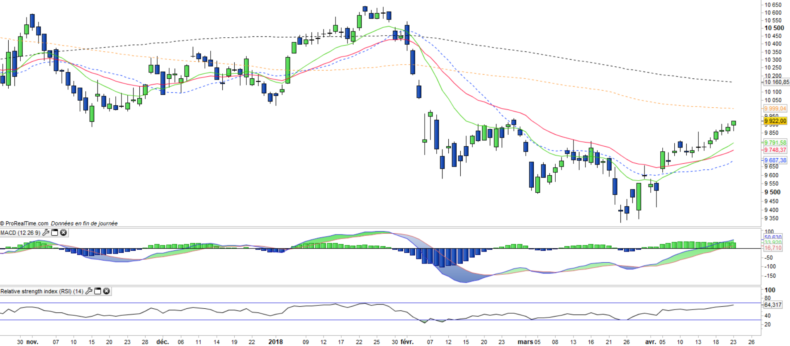Lyxor ETF IBEX (LYXIB) - 24/04/2018
Short Term strategy: Neutral (50%) / Trend +
Long Term strategy : Negative (35%) / Trend -
Characteristics of the ETF
ETF Lyxib (Lyxor) replicates the Spanish index, which is composed of the country's top 35 stocks weighted according to the market capitalization and adjusted according to the liquidity of each company included in the index.
The expenses of the ETF are 0.3%, while the AUM reach around 1057M €. Replication is direct (physical) and there is a dividend distribution on a half-yearly basis.
Alternative ETFs: DXIBD (DX-Deutsche Bank), EWP (iShares in USD)
Latest developments
The IBEX35 rose by 7.4% in 2017, which is lower than the STOXX600 (10.6%), because the Spanish index stalled from May and returned a good part of its earnings which is related to political problems caused by the attempt of independence of Catalonia, the most important region of Spain from the economic point of view with 16% of the population and 20% of the national GDP.
In 2018 the index is again weaker than the index and down 1.2% due to the banking sector and the consolidation supported by Inditex (-15.8% since January 1, 2018) the second market capitalization of the index that is experiencing a transition phase on its distribution model.
The Spanish economy grew by 3.1% in 2017 despite the thorny problem of Catalan independence. In 2018 GDP should continue to grow by around 3%, but the uncertainty on Catalonia remains unresolved, whereas no negotiated solution seems possible in the short term.
Index & components
This index, like that of Italy, has the particularity of being very overweight in financials, which represent more than a third (35.3%) of its composition (against around 20% for stoxx600), including Banco Santander, BBVA and Caixa Bank, while alongside industry (14.6%), consumer goods represent also a significant weight (9.6%) which is mainly due to Inditex which weighs more than € 100bn of market capitalization, as well as utilities (13.7%), which include Iberdrola, Ferrovial and Abertis.
The 10 largest capitalisations account for almost two thirds of the index, in addition to the companies already named they also include telecom giant Telefonica as well as the oil group Repsol.
The IBEX was under pressure in 2016 due to the bad behavior of the European banking sector, and the political problems that left Spain in uncertainty for many months and without government, while its macroeconomic situation improved significantly but suffered from its strong exposure to Latin America under pressure for 2 years, which is linked in particular to Brazil and Venezuela. However, the Brazilian economy seems to be coming out of recession while Argentina, Colombia and Peru benefit from "pro-business" governments. The political risks have moved away with a resumption of the government by Mr Rajoy and a relative weakening of the populist "Podemos" big losers of the legislative elections of July 2016.
In 2017, Spain saw its GDP grow by 3.1% keeping the same pace as in 2016, a figure well above that of the euro area which reached 2.5% in 2017, and continues at the same pace in 2018. The fourth largest economy in the euro area, has just registered its sixteenth consecutive quarter of growth since late 2013, after a descent into hell began in 2008 in the aftermath of the real estate and financial crisis.
Two factors specific to Spain made possible the sharp rise in GDP confirmed in 2017: the recovery of the labor market, whereas between 2013 and the end of 2016, the unemployment rate went from 27% to 18% and 1, 2 million jobs have been created. The second explanation concerns the profitability of companies which has become one of the best in Europe, which can be explained by the reorientation of Spanish companies towards exports after the collapse of the domestic market.
Weekly data
The weekly chart shows a downward trend but is trying to turn upside down. The pivot point and the main resistance is represented by the weekly EMA100, which corresponds to the current level of the index. A confirmed exceedance of this resistance would change the medium term configuration of the index. The bullish reversal of the MACD pleads in this direction.
Daily data
On the daily chart, we can see that prices have turned upward in the short term and are currently on the resistance materialized by the daily EMA100 and the previous lows of autumn 2017. The reversal is under way, already validated by the technical oscillators but will have to pass the psychological threshold of 10000 pts to be confirmed.
ETF Objective
LYXIB is a UCITS ETF listed in €, which seeks to replicate the IBEX35 index (35 spanish companies)
Characteristics
| Inception date | 19/01/2006 |
| Expense ratio | 0,30% |
| Issuer | Lyxor |
| Benchmark | Indice IBEX 35 Net Return |
| Code/Ticker | LYXIB |
| ISIN | FR0010251744 |
| Currency | € |
| Exchange | Euronext Paris |
| Assets Under Management | 1 057 M€ |
| Replication method | Direct (Physical) |
| PEA (France) | Yes |
| SRD (France) | Yes |
| Dividend | Distribution |
| Currency risk | No |
| Number of Holdings | 35 |
| Risk | 4/5 |
Country Breakdown
| Spain | 96% |
| United Kingdom | 3% |
| Luxemburg | 1% |
Sector Breakdown
| Financials | 35% |
| Industrials | 15% |
| Utilities | 14% |
| Consumer discretionary | 10% |
| Telecom services | 9% |
| Energy | 6% |
| Information Technology | 6% |
| Others | 6% |
Top Ten Holdings
| Banco Santander | 17% |
| Inditex | 9% |
| Banco Bilbao | 8% |
| Telefonica | 8% |
| Iberdrola | 8% |
| Amadeus IT | 5% |
| Caixa Bank | 5% |
| Repsol | 5% |
| Abertis | 3% |
| Aena | 3% |


